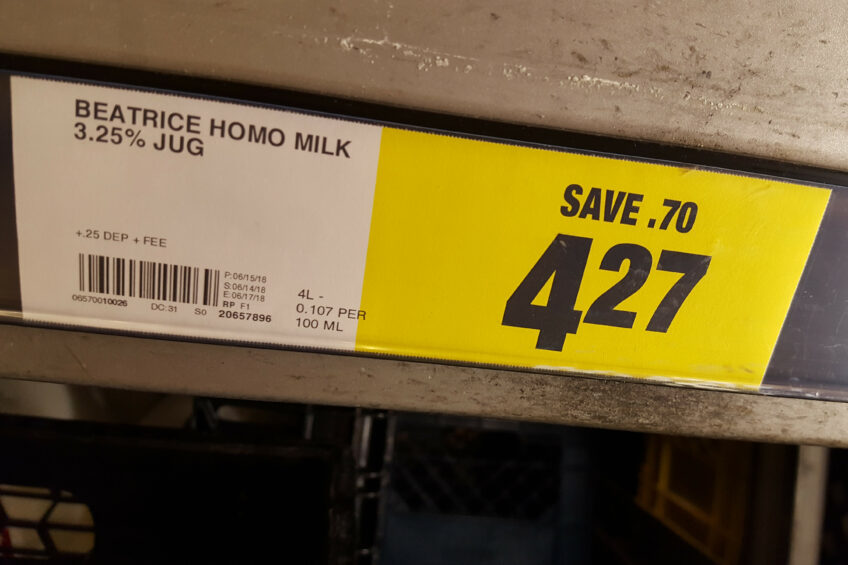Canada: Phase out supply management?

While Canada’s dairy farmers are happy with its stability, others think it stymies growth and innovation.
As Canada and the United States slog through the final details of NAFTA renegotiations and have yet to reach an agreement, there are probably no 2 words more contentious than ‘supply management’. Canada’s supply management system is easily one of the most misunderstood agricultural policies both at home and abroad. While experts defend, demur and debate the system, Canadian dairy farmers share what supply management means to them.
What is supply management and how does it work?
Supply management has 3 main pillars:
- production control,
- pricing mechanism,
- import control.
In Canada, eggs, poultry meat and dairy are supply managed. Bruce Muirhead, a Canadian historian and University of Waterloo professor who focuses on Canada’s foreign trade policy, explains how the system works. To determine milk prices, industry stakeholders, including restaurant and consumer associations and farmers, consider over 20 variables, including insurance costs, equipment depreciation, cost of feed and heating, as well as farmer salaries.

The second pillar regulates production through the use of quotas. Quota in Canada has been monetised and costs about CAD$ 24,000/kg of milk solids. A kilogram of milk solids is roughly equal to 1 cow, so 50kg of milk solid quota would allow a farmer to milk about 55 milking cows, said Mr Muirhead. The average dairy farm in Canada milks 80 cows. Milk prices average CAD$ 1.07/L at the retail level. In order for the other 2 pillars to work, the 3rd pillar, import control, is absolutely necessary. “It’s a highly regulated system where we basically produce milk for our own purposes, which is a domestic-focused market, and we don’t allow imports,” explained Mr Muirhead. “The system would crumble if we did.”
The problem of overproduction
One of the reasons the system would crumble without supply management is overproduction, which is a huge problem globally. In a global market where just 7% of milk produced is traded, the world’s biggest players – New Zealand, Europe, the United States, and Australia – heavily compete for a small slice of the pie. Dairy farmers on the open market have to rely on volume sales as opposed to quality sales in order to make ends meet, Mr Muirhead said. “If you’re big enough, you can keep your head above water,” he added. “But if you’re milking say 150 or 200 cows in the US, it’s not a good game for you to be in.”
Also read: FAO: More milk and more international trade
Support and criticism for supply management
As NAFTA talks draw to a close, supply management has become a hot issue in Canada. Some, like former Progressive Conservative Member of Parliament Maxime Bernier, believe supply management needs to be phased out like it was in Australia. The system, he said, offers no benefit to 90% of Canada’s farmers, but protects a small cartel of dairy, poultry and egg farmers at the expense of everyone else. Mr Bernier believes supply management also creates massive entry barriers for new farmers, as the cost of purchasing quota is too high, and drives up grocery bills. “Phasing out supply management, and ensuring that those in supply managed sectors can transition is the right thing to do,” Mr Bernier said. “I would follow the Australian model, with a gradual phase-out and compensation for farmers.”
Supply Management 2.0
In a recent interview with CTV News, Graham Lloyd, General Manager and CEO of Dairy Farmers of Ontario, said supply management is worth defending. “When you look at the system and you compare it with what’s happening in the United States or even Australia and New Zealand, they’re requiring government bailouts and significant government protection,” Mr Lloyd said.
Canada’s system doesn’t take any taxpayer dollars or government handouts. Somewhere between the 2 sides of the polarised debate sits Sylvain Charlebois, Professor of Food Distribution and Policy at Dalhousie University in Nova Scotia. Mr Charlebois is not in favour of abolishing the system, but believes it needs serious reforming. Supply management, he said, has “severe limitations” and doesn’t actually achieve its initial goal of preserving family farms. Ideally, Supply Management 2.0, as Mr Charlebois calls it, would focus on economic growth through innovation and competitiveness. He believes there is great potential for Canadian products on the export market. Setting up export quotas could enable this possibility, he said. Mr Charlebois’ system would give greater access to imported goods or adapt a schedule of reduced tariffs over 15–20 years. Mr Charlebois was clear on one point, though. The quota system would remain. “We have a very closed, ideologically-driven system that has no synchronisation with the modern world,” he said.
Be surrounded by supply-managed farms
Maurice Doyon, professor in the Department of Agri-Food Economics and Consumer Science at Université Laval in Quebec, conducted a study on the economic impact of supply management in Canada. The research found that rural communities surrounded by supply-managed farms tended to thrive economically in comparison to those surrounded by non-supply managed businesses. Non-supply managed farmers like cash crop, pig and beef producers tend to have limited cash flow, he pointed out, whereas supply managed businesses receive regular pay-cheques. Agribusinesses, like machinery suppliers, mechanics, and feed suppliers, rely on supply management for stable income as well, he said. “You can make a decent living in Canada with 75 cows, and that creates smaller farms,” he said. “Those smaller farms are all over the country and they are very important economic engines for those regions.” Recently, Mr Doyon completed another survey that shows supply managed farms do invest more into improving their businesses than non-supply managed farms. “If I know that the price is not going to collapse by 40% in the next 6 months, I’m much more likely to invest than if I think it’s going to collapse or if I have a doubt,” Mr Doyon explained.
Canadian dairy farmers weigh in
At nearly 79-years of age, retired dairy farmer Mike Jones knows both sides of the debate well. As a young man growing up in the pre-supply management era in Caledonia, Ontario, he managed ice cream and milk processing plants. Later, when supply management came into play, he pursued his dream of becoming a dairy farmer. “Before supply management came in, you had an awful big pile of manure to look at at Christmas – and a very small bank account,” Mr Jones said. “Today, I think dairy prices [in Canada] are the most reasonable prices of any country in the world,” he said. “I think it’s a good bargain for consumers and a good bargain for the country.”
Second-generation dairy farmer Tessa Weenink, 33, and her husband Adam, 34, operate a medium-sized dairy farm in Brooks, Alberta, along with her parents.
For Ms Weenink, supply management means stability. “I don’t think we could have gotten as far as we have if we didn’t have the stability,” she said. “Banks like quota. It is a consistent asset. They can predict our income; we can predict our income.” Supply management isn’t perfect, though, she concedes. While it provides stability, it limits expansion opportunities. Ms Weenink also points out that while production costs have risen, milk prices have stayed pretty much the same for the past 15 years. “But I look around the globe and at least we get a voice at the pricing table,” she added.
Bruce Sargent, 23, agrees. While Mr Sargent operates a video production business in agriculture, his parents and 4 siblings run the family farm near Bowmanville, Ontario, where they milk 60 cows. “A fair price is one thing, but it also gives all the farmers in Canada a unified voice for negotiating that price,” he said. “Without the unified voice of supply management in the US the farmers just have no say and no power whatsoever with the processors.” As a young producer, Mr Sargent sees the quota system as an investment in stability. Although he’s chosen to work off-farm, he’s confident that his siblings will be able to take over the farm when the time comes.
Emotional downside to supply management
Across Canada, you’d be hard pressed, in fact, to find a single dairy farmer who stands in opposition to supply management. Many say that watching the online debate get more and more heated as NAFTA negotiations came to a close made them ill at ease. In Owen Sound, Ontario, Courtney Denard and her husband, Rob, just invested CAD$ 1.3 million in a new robotic milking barn. Before doing so, though, they worked closely with a business consultant to stress test their financial situation. Ms Denard said that being a part of the free market would make finances tougher to predict and loans more difficult to obtain. There’s an emotional downside to supply management, she said, and that’s the constant worry that it will be abolished. “You are always worried that it’s going to go, especially lately,” Ms Denard said. “As dairy farmers, we do worry about it a lot because we have millions of dollars invested in this business.” Despite the worry, Ms Denard remains positive. “Our goal is to be in the top 10% of dairy farms in Ontario, so if and when supply management does go, we are running a profitable business,” she said.
Dairy Farmers of Ontario CEO Graham Lloyd doesn’t believe supply management will be abolished. He says keeping it is in the best interest of the Canadian economy.
“Dairy adds $ 20 billion to the national GDP and $ 6 billion alone in Ontario, so there are good reasons why the government wants to continue to protect this.”
Join 13,000+ subscribers
Subscribe to our newsletter to stay updated about all the need-to-know content in the dairy sector, two times a week.










